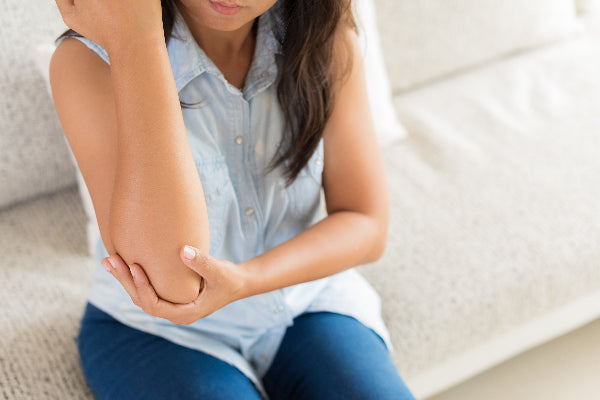Tennis Elbow vs Golfer's Elbow - Natural Remedies For Elbow Pain From Tennis & Golfer's Elbow
Elbow pain can be – well – a pain. It's a tricky area to treat, and conventional treatments aren't always effective. Two of the most common types of elbow pain are tennis elbow and golfer's elbow. Even if you've never picked up a golf club or tennis racket in your life, you can still develop these overuse injuries. Tennis elbow vs golfer's elbow: what exactly is the difference? What natural remedies for elbow pain may help pain caused by these two conditions?
Tennis Elbow vs Golfer's Elbow: What's the Difference?

While anyone can develop elbow pain, there are two sports that are known to cause problems in this area of the body: tennis and golf. But even if you don't play these sports, you can still develop these conditions from overuse.
At first, you may think "tennis elbow vs golfer's elbow: there is no difference", but these two conditions affect different parts of the elbow.
What is Tennis Elbow?
Tennis elbow is an overuse injury that's common in middle-aged individuals. This muscle strain injury is caused by inflammation along the outside of the elbow and forearm.
Repetitive movements are the main cause of this injury. While it can affect tennis players (hence the name), carpenters, plumbers, painters, and those who engage in other similar work can develop this injury. Some people develop tennis elbow after doing yard work, like cutting wood or raking leaves.
Although up to 50% of tennis players will be diagnosed with tennis elbow, they make up only 5% of all people who have this condition.
Symptoms of Tennis Elbow
- Pain or tenderness when performing everyday activities, like lifting, gripping, or grasping
- Weak grip strength
- Sharp bursts of pain when performing activities involving the elbow or wrist
- Dull aches when resting
- Tingling or numbness in the fingers
In most cases, tennis elbow affects the dominant arm. So, if you're right-handed, you're more likely to develop tennis elbow in your right arm. That being said, some people can develop this condition in both elbows.
What is Golfer's Elbow?
Unlike tennis elbow, golfer's elbow affects the inner side of the elbow and arm. This overuse injury is often the result of repeated flexing and twisting of the wrist. Overuse of the forearm muscles can lead to the development of golfer's elbow.
In addition to golfing, you can also develop this condition from other activities and sports, like:
- Gardening
- Shoveling
- Painting
- Carpentry
- Lifting weights
- Softball or baseball
- Throwing a ball
Like with tennis elbow, you don't have to play sports to develop this condition. Golfer's elbow is common among assembly line workers who repeatedly have to bend and straighten their elbows.
Golfer's elbow is most common in people over the age of 40 and those who perform repetitive tasks for at least two hours a day.
Symptoms of Golfer's Elbow
- Pain on the inside of the elbow
- Pain when twisting the forearm or making a fist
- Swelling and tenderness
2 Natural Remedies for Elbow Pain

While rest and gentle exercises can help, there are natural remedies that you can try to alleviate your elbow pain, such as:
1. Pain Relieving Creams
Pain-relieving creams can be effective at reducing or even eliminating pain. Creams have many advantages:
- They can be applied directly to the painful area.
- They have minimal (if any) side effects.
Some ingredients are more effective than others at alleviating pain topically, including:
- DMSO: Easily absorbed by the skin, DMSO has been used to treat osteoarthritis, injuries, wounds, and burns. When used properly, it can be an effective pain reliever.
- Essential oils: Many natural essential oils have pain-relieving effects, including frankincense, lavender, eucalyptus, sandalwood, and more.
Creams containing one or more of these ingredients can provide quick and powerful elbow pain relief.
2. Turmeric and Ginger
Turmeric and ginger are two roots that are known for their anti-inflammatory and pain-relieving properties. Both can act as analgesics.
New research shows that turmeric may be effective at alleviating knee osteoarthritis pain. In that study, the participants who took 1,000 mg of turmeric each day for 12 weeks had better pain outcomes than those taking a placebo.
Ginger has similar effects, with research showing that its anti-inflammatory effects can be helpful at alleviating pain.
Along with supplements and creams, compression and support can also go a long way in helping with the pain. Compression encourages blood flow to the injured area, which can help with pain and promote healing.
